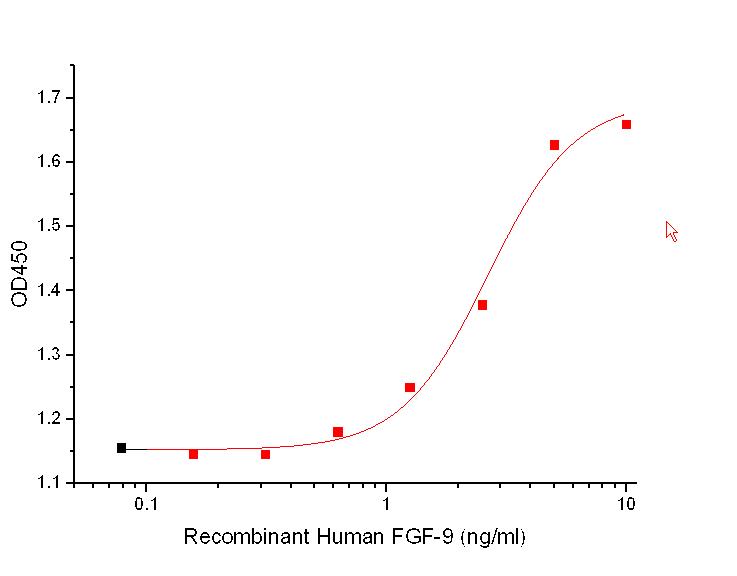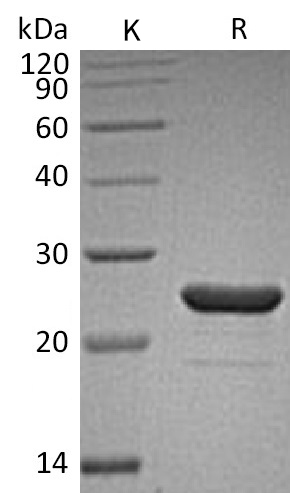- Remove All
 Your shopping cart is currently empty
Your shopping cart is currently empty
FGF-9 Protein, Human, Recombinant
Fibroblast Growth Factor 9 (FGF-9) belongs to the Fibroblast growth factor (FGF) family. FGF family members possess broad mitogenic and cell survival activities, and are involved in a variety of biological processes, including embryonic development, cell growth, morphogenesis, tissue repair, tumor growth and invasion. FGF-9 plays an important role in the regulation of embryonic development, cell proliferation, cell differentiation and cell migration. In addition, FGF-9 may have a role in glial cell growth and differentiation during development, gliosis during repair and regeneration of brain tissue after damage, differentiation and survival of neuronal cells, and growth stimulation of glial tumors.

FGF-9 Protein, Human, Recombinant
| Pack Size | Price | Availability | Quantity |
|---|---|---|---|
| 10 μg | $92 | In Stock | |
| 50 μg | $279 | 7-10 days | |
| 500 μg | $983 | 7-10 days | |
| 1 mg | $2,180 | 7-10 days |
Product Information
| Biological Activity | Measured in a cell proliferation assay using Balb/3T3 mouse embryonic fibroblast cells. The ED50 for this effect is 1-5 ng/ml. (QC verified)  |
| Description | Fibroblast Growth Factor 9 (FGF-9) belongs to the Fibroblast growth factor (FGF) family. FGF family members possess broad mitogenic and cell survival activities, and are involved in a variety of biological processes, including embryonic development, cell growth, morphogenesis, tissue repair, tumor growth and invasion. FGF-9 plays an important role in the regulation of embryonic development, cell proliferation, cell differentiation and cell migration. In addition, FGF-9 may have a role in glial cell growth and differentiation during development, gliosis during repair and regeneration of brain tissue after damage, differentiation and survival of neuronal cells, and growth stimulation of glial tumors. |
| Species | Human |
| Expression System | E. coli |
| Tag | Tag Free |
| Accession Number | P31371 |
| Synonyms | Heparin-Binding Growth Factor 9,HBGF-9,Glia-Activating Factor,GAF,Fibroblast Growth Factor 9,FGF-9,FGF9 |
| Amino Acid | Met1-Ser208 |
| Construction | Met1-Ser208 |
| Protein Purity | Greater than 95% as determined by reducing SDS-PAGE. (QC verified)  |
| Molecular Weight | 25 KDa (reducing condition) |
| Endotoxin | < 1 EU/μg by the LAL method. |
| Formulation | Lyophilized from a solution filtered through a 0.22 μm filter, containing 20 mM PB, 220 mM Sucrose , 0.02% Tween 80 , pH 6.0. |
| Reconstitution | Reconstitute the lyophilized protein in distilled water. The product concentration should not be less than 100 μg/ml. Before opening, centrifuge the tube to collect powder at the bottom. After adding the reconstitution buffer, avoid vortexing or pipetting for mixing. |
| Stability & Storage | Lyophilized powders can be stably stored for over 12 months, while liquid products can be stored for 6-12 months at -80°C. For reconstituted protein solutions, the solution can be stored at -20°C to -80°C for at least 3 months. Please avoid multiple freeze-thaw cycles and store products in aliquots. |
| Shipping | In general, Lyophilized powders are shipping with blue ice. Solutions are shipping with dry ice. |
| Research Background | Fibroblast Growth Factor 9 (FGF-9) belongs to the Fibroblast growth factor (FGF) family. FGF family members possess broad mitogenic and cell survival activities, and are involved in a variety of biological processes, including embryonic development, cell growth, morphogenesis, tissue repair, tumor growth and invasion. FGF-9 plays an important role in the regulation of embryonic development, cell proliferation, cell differentiation and cell migration. In addition, FGF-9 may have a role in glial cell growth and differentiation during development, gliosis during repair and regeneration of brain tissue after damage, differentiation and survival of neuronal cells, and growth stimulation of glial tumors. |
Dose Conversion
Calculator
Tech Support

Copyright © 2015-2025 TargetMol Chemicals Inc. All Rights Reserved.


